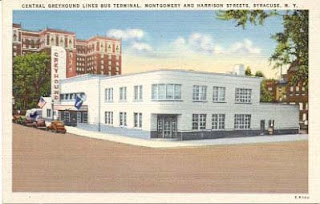 |
| Syracuse Herald, June 5, 1923 |
Though most of the landmarks of my childhood experience in Syracuse are long gone, one remains steadfast: the necessity of a car to travel anywhere in the city. The Mountain Goat provided a ten-mile traffic-free tour in about the same time it would take to walk from the Regional Transportation Center to Downtown Syracuse (if the pedestrian unfriendly route didn’t cause the ultimate DNF). A taxi ride would cost approximately $15, an expense equivalent to half the entry fee of the race. Ironically, one could walk to the start line of the Empire State Marathon from the bus station, but picking up the race packet would require a 9 mile trip to—of all places—Driver’s Village. With no race-provided shuttle, taxi fare plus tip would be close to $40—the price of a Greyhound bus from New York to Syracuse. Walking would be its own medaled event.

While car-free visitors are left to their wits and a detailed “beer trail” map, the SCVB is busy counting license plates of out-of-town cars in the
The Regional Transportation Center recently expanded its parking lot to accommodate the increased number of Amtrak and Greyhound passengers:
The number of people who use the inter-city transportation services at the Transportation Center has grown significantly since we opened in 1998,” said Central New York Regional Transportation Center Executive Director Frank Kobliski. “We have reached a point where we need to expand to accommodate our customers.”
Not only is it ironic that Syracuse acknowledged an increase in bus and train travel by adding more parking spots for cars, but the plan is completely one-sided. If more people are leaving Syracuse by train and bus, wouldn’t it stand to reason that more are arriving by these same modes of travel? And if so, where are their accommodations? The only improvement geared towards pedestrians is the addition of “direct sidewalk access between the facility’s main entrance and a new sheltered taxi stand,” where presumably visitors can remain dry before their wallets get hosed.
 |
| Former Greyhound terminal in downtown Syracuse. Opened in 1941, razed in 1960s for construction of MONY Plaza. |
Syracuse seems forever caught up in its car culture, extending its bias even towards the new Centro bus hub. Apparently, the $18.8 million, 38-years-in-the-making project was never meant to revitalize downtown by encouraging more mass transit use, but rather, be transformative by removing bus-riding pedestrians from the path of car-owning pedestrians. Why not utilize the hub as an additional stop for Greyhound and Megabus, allowing visitors to walk to a hotel or through the new-and-improved downtown? (Though one has to ask, if “downtown living” still requires a car, do any of the much-ballyhooed downtown condo dwellers truly “live downtown”?)
Shortly after my springtime visit, Syracuse went agog with the news that the Wegmans Pond Street location would close by month’s end, potentially leaving the area’s elderly and non-driving residents without a supermarket within walking distance:
Nicoletti said he doesn’t buy into Wegmans’ numbers and said the company is abandoning shoppers who rely on the store because they can walk there.
“It is an area in transition, an area we are fighting for, and the city is fighting for,” said Nicoletti. “They worry about a TV commercial with Alec Baldwin. They should worry about people who don’t have vehicles, who are handicapped.
If Syracuse’s chickens were going to come home to roost, then perhaps it is only fitting that they did so at a Wegmans. While this crisis seemed to be quieted by the later announcement of a Tops in the same location, where is the uproar for the senior suburb dwellers who in due time may have to give up their car keys? My parents don't have the option of walking to a supermarket or even a bus stop. Without a car, they will be as stranded at their house as I am without their ride when I come home to visit. A sobering reality from which I cannot run away.

1 comment:
great article!
Taxi Melbourne
Post a Comment